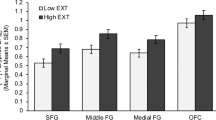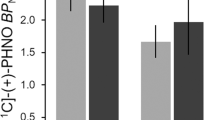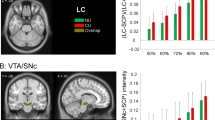Abstract
Stimulant use disorders are associated with deficits in striatal dopamine receptor availability, abnormalities in mesocorticolimbic resting-state functional connectivity (RSFC) and impulsivity. In methamphetamine-dependent research participants, impulsivity is correlated negatively with striatal D2-type receptor availability, and mesocorticolimbic RSFC is stronger than that in controls. The extent to which these features of methamphetamine dependence are interrelated, however, is unknown. This question was addressed in two studies. In Study 1, 19 methamphetamine-dependent and 26 healthy control subjects underwent [18F]fallypride positron emission tomography to measure ventral striatal dopamine D2-type receptor availability, indexed by binding potential (BPND), and functional magnetic resonance imaging (fMRI) to assess mesocorticolimbic RSFC, using a midbrain seed. In Study 2, an independent sample of 20 methamphetamine-dependent and 18 control subjects completed the Barratt Impulsiveness Scale in addition to fMRI. Study 1 showed a significant group by ventral striatal BPND interaction effect on RSFC, reflecting a negative relationship between ventral striatal BPND and RSFC between the midbrain and striatum, orbitofrontal cortex and insula in methamphetamine-dependent participants, but a positive relationship in the control group. In Study 2, an interaction of the group with RSFC on impulsivity was observed. Methamphetamine-dependent users exhibited a positive relationship of midbrain RSFC to the left ventral striatum with cognitive impulsivity, whereas a negative relationship was observed in healthy controls. The results indicate that ventral striatal D2-type receptor signaling may affect the system-level activity within the mesocorticolimbic system, providing a functional link that may help explain high impulsivity in methamphetamine-dependent individuals.
This is a preview of subscription content, access via your institution
Access options
Subscribe to this journal
Receive 12 print issues and online access
$259.00 per year
only $21.58 per issue
Buy this article
- Purchase on Springer Link
- Instant access to full article PDF
Prices may be subject to local taxes which are calculated during checkout


Similar content being viewed by others
References
Groman SM, Lee B, Seu E, James AS, Feiler K, Mandelkern MA et al. Dysregulation of D(2)-mediated dopamine transmission in monkeys after chronic escalating methamphetamine exposure. J Neurosci 2012; 32: 5843–5852.
Lee B, London ED, Poldrack RA, Farahi J, Nacca A, Monterosso JR et al. Striatal dopamine d2/d3 receptor availability is reduced in methamphetamine dependence and is linked to impulsivity. J Neurosci 2009; 29: 14734–14740.
London ED, Kohno M, Morales AM, Ballard ME . Chronic methamphetamine abuse and corticostriatal deficits revealed by neuroimaging. Brain Res 2014; 1628: 174–185.
Kohno M, Morales AM, Ghahremani DG, Hellemann G, London ED . Risky decision making, prefrontal cortex, and mesocorticolimbic functional connectivity in methamphetamine dependence. JAMA Psychiatry 2014; 71: 812–820.
Dalley JW, Everitt BJ, Robbins TW . Impulsivity, compulsivity, and top-down cognitive control. Neuron 2011; 69: 680–694.
Martinez D, Carpenter KM, Liu F, Slifstein M, Broft A, Friedman AC et al. Imaging dopamine transmission in cocaine dependence: link between neurochemistry and response to treatment. Am J Psychiatry 2011; 168: 634–641.
Wang GJ, Smith L, Volkow ND, Telang F, Logan J, Tomasi D et al. Decreased dopamine activity predicts relapse in methamphetamine abusers. Mol Psychiatry 2012; 17: 918–925.
Ballard ME, Mandelkern MA, Monterosso JR, Hsu E, Robertson CL, Ishibashi K et al. Low Dopamine D2/D3 Receptor Availability is Associated with Steep Discounting of Delayed Rewards in Methamphetamine Dependence. Int J Neuropsychopharmacol 2015; 18: pyu 119.
Floresco SB, Magyar O . Mesocortical dopamine modulation of executive functions: beyond working memory. Psychopharmacology (Berl) 2006; 188: 567–585.
Floresco SB, Tse MT, Ghods-Sharifi S . Dopaminergic and glutamatergic regulation of effort- and delay-based decision making. Neuropsychopharmacology 2008; 33: 1966–1979.
Nestler EJ, Aghajanian GK . Molecular and cellular basis of addiction. Science 1997; 278: 58–63.
Robinson TE, Berridge KC . The neural basis of drug craving: an incentive-sensitization theory of addiction. Brain Res Brain Res Rev 1993; 18: 247–291.
Robinson TE, Berridge KC . Review The incentive sensitization theory of addiction: some current issues. Philos Trans R Soc Lond B Biol Sci 2008; 363: 3137–3146.
Robinson TE, Gorny G, Mitton E, Kolb B . Cocaine self-administration alters the morphology of dendrites and dendritic spines in the nucleus accumbens and neocortex. Synapse 2001; 39: 257–266.
Robinson TE, Kolb B . Persistent structural modifications in nucleus accumbens and prefrontal cortex neurons produced by previous experience with amphetamine. J Neurosci 1997; 17: 8491–8497.
Robinson TE, Kolb B . Structural plasticity associated with exposure to drugs of abuse. Neuropharmacology 2004; 47: 33–46.
Koob GF, Volkow ND . Neurocircuitry of addiction. Neuropsychopharmacology 2010; 35: 217–238.
First MB, Spitzer RL, Gibbon M, Williams JB . The Structured Clinical Interview for DSM-IV Axis I Disorders (SCID-IP). American Psychiatric Press:: Washington, DC, USA, 1995.
Sheehan DV, Lecrubier Y, Sheehan KH, Amorim P, Janavs J, Weiller E et al. The Mini-International Neuropsychiatric Interview (M.I.N.I.): the development and validation of a structured diagnostic psychiatric interview for DSM-IV and ICD-10. J Clin Psychiatry 1998; 59: 22–33.
Bilder RM, Sabb FW, Parker DS, Kalar D, Chu WW, Fox J et al. Cognitive ontologies for neuropsychiatric phenomics research. Cogn Neuropsychiatry 2009; 14: 419–450.
Patton JH, Stanford MS, Barratt ES . Factor structure of the Barratt impulsiveness scale. J Clin Psychol 1995; 51: 768–774.
Reise SP, Moore TM, Sabb FW, Brown AK, London ED . The Barratt Impulsiveness Scale-11: reassessment of its structure in a community sample. Psychol Assess 2013; 25: 631–642.
Mukherjee J, Yang ZY, Das MK, Brown T . Fluorinated benzamide neuroleptics—III. Development of (S)-N-[(1-allyl-2-pyrrolidinyl)methyl]-5-(3-[18F]fluoropropyl)-2, 3-dimethoxybenzamide as an improved dopamine D-2 receptor tracer. Nucl Med Biol 1995; 22: 283–296.
Jenkinson M, Bannister P, Brady M, Smith S . Improved optimization for the robust and accurate linear registration and motion correction of brain images. Neuroimage 2002; 17: 825–841.
Power JD, Barnes KA, Snyder AZ, Schlaggar BL, Petersen SE . Spurious but systematic correlations in functional connectivity MRI networks arise from subject motion. NeuroImage 2011; 59: 2142–2154.
Andersson J, Jenkinson M, Smith S 2007 Non-linear Registration, aka Spatial Normalisation. FMRIB Centre: Oxford, UK, 2007, FMRIB Technial Report TR07JA2.
Jenkinson M, Smith S . A global optimisation method for robust affine registration of brain images. Med Image Anal 2001; 5: 143–156.
Patenaude B, Smith SM, Kennedy DN, Jenkinson M . A Bayesian model of shape and appearance for subcortical brain segmentation. Neuroimage 2011; 56: 907–922.
Lammertsma AA, Hume SP . Simplified reference tissue model for PET receptor studies. Neuroimage 1996; 4: 153–158.
Vandehey NT, Moirano JM, Converse AK, Holden JE, Mukherjee J, Murali D et al. High-affinity dopamine D2/D3 PET radioligands 18F-fallypride and 11C-FLB457: a comparison of kinetics in extrastriatal regions using a multiple-injection protocol. J Cereb Blood Flow Metab 2010; 30: 994–1007.
Wu Y, Carson RE . Noise reduction in the simplified reference tissue model for neuroreceptor functional imaging. J Cereb Blood Flow Metab 2002; 22: 1440–1452.
Pohjalainen T, Rinne JO, Nagren K, Syvalahti E, Hietala J . Sex differences in the striatal dopamine D2 receptor binding characteristics in vivo. Am J Psychiatry 1998; 155: 768–773.
Ngun TC, Ghahramani N, Sanchez FJ, Bocklandt S, Vilain E . The genetics of sex differences in brain and behavior. Front Neuroendocrinol 2010; 32: 227–246.
Grady CL, Grigg O, Ng C . Age differences in default and reward networks during processing of personally relevant information. Neuropsychologia 2012; 50: 1682–1697.
Garrett DD, Kovacevic N, McIntosh AR, Grady CL . The modulation of BOLD variability between cognitive states varies by age and processing speed. Cereb Cortex 2012; 23: 684–693.
Kohno M, Morales AM, Ghahremani DG, Hellemann G, London ED . Risky decision-making: prefrontal function and mesocorticolimbic resting-state connectivity in methamphetamine users. JAMA Psychiatry 2014; 71: 812–820.
Trifilieff P, Martinez D . Imaging addiction: D2 receptors and dopamine signaling in the striatum as biomarkers for impulsivity. Neuropharmacology 2014; 76: 498–509.
Kalivas PW . Neurotransmitter regulation of dopamine neurons in the ventral tegmental area. Brain Res Brain Res Rev 1993; 18: 75–113.
Volkow ND, Wang GJ, Fowler JS, Logan J, Gatley SJ, Hitzemann R et al. Decreased striatal dopaminergic responsiveness in detoxified cocaine-dependent subjects. Nature 1997; 386: 830–833.
Rahman S, McBride WJ . Feedback control of mesolimbic somatodendritic dopamine release in rat brain. J Neurochem 2000; 74: 684–692.
Konova AB, Moeller SJ, Tomasi D, Volkow ND, Goldstein RZ . Effects of methylphenidate on resting-state functional connectivity of the mesocorticolimbic dopamine pathways in cocaine addiction. JAMA Psychiatry 2013; 26: 1–11.
Cole DM, Oei NY, Soeter RP, Both S, van Gerven JM, Rombouts SA et al. Dopamine-dependent architecture of cortico-subcortical network connectivity. Cereb Cortex 2012; 23: 1509–1516.
Schrantee A, Ferguson B, Stoffers D, Booij J, Rombouts S, Reneman L . Effects of dexamphetamine-induced dopamine release on resting-state network connectivity in recreational amphetamine users and healthy controls. Brain Imaging Behav 2015; 7: 1–11.
Dalley JW, Fryer TD, Brichard L, Robinson ES, Theobald DE, Laane K et al. Nucleus accumbens D2/3 receptors predict trait impulsivity and cocaine reinforcement. Science 2007; 315: 1267–1270.
Jupp B, Caprioli D, Saigal N, Reverte I, Shrestha S, Cumming P et al. Dopaminergic and GABA-ergic markers of impulsivity in rats: evidence for anatomical localisation in ventral striatum and prefrontal cortex. Eur J Neurosci 2013; 37: 1519–1528.
Cardinal RN, Pennicott DR, Sugathapala CL, Robbins TW, Everitt BJ . Impulsive choice induced in rats by lesions of the nucleus accumbens core. Science 2001; 292: 2499–2501.
Besson M, Belin D, McNamara R, Theobald DE, Castel A, Beckett VL et al. Dissociable control of impulsivity in rats by dopamine d2/3 receptors in the core and shell subregions of the nucleus accumbens. Neuropsychopharmacology 2010; 35: 560–569.
Hu Y, Salmeron BJ, Gu H, Stein EA, Yang Y . Impaired functional connectivity within and between frontostriatal circuits and its association with compulsive drug use and trait impulsivity in cocaine addiction. JAMA Psychiatry 2015; 72: 584–592.
White JL, Moffitt TE, Caspi A, Bartusch DJ, Needles DJ, Stouthamer-Loeber M . Measuring impulsivity and examining its relationship to delinquency. J Abnorm Psychol 1994; 103: 192–205.
Dean AC, Groman SM, Morales AM, London ED . An evaluation of the evidence that methamphetamine abuse causes cognitive decline in humans. Neuropsychopharmacology 2012; 38: 259–274.
Monterosso JR, Aron AR, Cordova X, Xu J, London ED . Deficits in response inhibition associated with chronic methamphetamine abuse. Drug Alcohol Depend 2005; 79: 273–277.
Tabibnia G, Monterosso JR, Baicy K, Aron AR, Poldrack RA, Chakrapani S et al. Different forms of self-control share a neurocognitive substrate. J Neurosci 2011; 31: 4805–4810.
Basar K, Sesia T, Groenewegen H, Steinbusch HW, Visser-Vandewalle V, Temel Y . Nucleus accumbens and impulsivity. Prog Neurobiol 2010; 92: 533–557.
Ghahremani DG, Lee B, Robertson CL, Tabibnia G, Morgan AT, De Shetler N et al. Striatal dopamine D(2)/D(3) receptors mediate response inhibition and related activity in frontostriatal neural circuitry in humans. J Neurosci 2012; 32: 7316–7324.
Robertson CL, Ishibashi K, Mandelkern MA, Brown AK, Ghahremani DG, Sabb F et al. Striatal D1- and D2-type dopamine receptors are linked to motor response inhibition in human subjects. J Neurosci 2015; 35: 5990–5997.
Ernst M, Nelson EE, McClure EB, Monk CS, Munson S, Eshel N et al. Choice selection and reward anticipation: an fMRI study. Neuropsychologia 2004; 42: 1585–1597.
Matthews SC, Simmons AN, Lane SD, Paulus MP . Selective activation of the nucleus accumbens during risk-taking decision making. Neuroreport 2004; 15: 2123–2127.
Kohno M, Ghahremani DG, Morales AM, Robertson CL, Ishibashi K, Morgan AT et al. Risk-taking behavior: dopamine D2/D3 receptors, feedback, and frontolimbic activity. Cereb Cortex 2015; 25: 236–245.
Tobler PN, Fiorillo CD, Schultz W . Adaptive coding of reward value by dopamine neurons. Science 2005; 307: 1642–1645.
Wise RA . Brain reward circuitry: insights from unsensed incentives. Neuron 2002; 36: 229–240.
Koob GF . Drugs of abuse: anatomy, pharmacology and function of reward pathways. Trends Pharmacol Sci 1992; 13: 177–184.
Brown AK, Mandelkern MA, Farahi J, Robertson C, Ghahremani DG, Sumerel B et al. Sex differences in striatal dopamine D2/D3 receptor availability in smokers and non-smokers. Int J Neuropsychopharmacol 2012; 15: 989–994.
Fehr C, Yakushev I, Hohmann N, Buchholz HG, Landvogt C, Deckers H et al. Association of low striatal dopamine d2 receptor availability with nicotine dependence similar to that seen with other drugs of abuse. Am J Psychiatry 2008; 165: 507–514.
Lerman C, Gu H, Loughead J, Ruparel K, Yang Y, Stein EA . Large-scale brain network coupling predicts acute nicotine abstinence effects on craving and cognitive function. JAMA Psychiatry 2014; 71: 523–530.
Morales AM, Kohno M, Robertson CL, Dean AC, Mandelkern MA, London ED . Gray-matter volume, midbrain dopamine D2/D3 receptors and drug craving in methamphetamine users. Mol Psychiatry 2015; 20: 764–771.
Mukherjee J, Christian BT, Dunigan KA, Shi B, Narayanan TK, Satter M et al. Brain imaging of 18F-fallypride in normal volunteers: blood analysis, distribution, test-retest studies, and preliminary assessment of sensitivity to aging effects on dopamine D-2/D-3 receptors. Synapse 2002; 46: 170–188.
Acknowledgements
The research described here was funded in part by NIH grants P20 DA022539, R01 DA020726 (EDL), NIDA R01DA027633 (RAR), K23DA027734 (ACD), R21DA034928 (ACD), UL1TR000124 (UCLA CTSA), the Consortium for Neuropsychiatric Phenomics (NIH Roadmap for Medical Research grants UL1-DE019580 and RL1DA024853) and endowments from the Thomas P and Katherine P. Pike Chair in Addiction Studies, and the Marjorie Greene Trust.
Author information
Authors and Affiliations
Corresponding author
Ethics declarations
Competing interests
The authors declare no conflict of interest.
PowerPoint slides
Rights and permissions
About this article
Cite this article
Kohno, M., Okita, K., Morales, A. et al. Midbrain functional connectivity and ventral striatal dopamine D2-type receptors: link to impulsivity in methamphetamine users. Mol Psychiatry 21, 1554–1560 (2016). https://doi.org/10.1038/mp.2015.223
Received:
Revised:
Accepted:
Published:
Issue Date:
DOI: https://doi.org/10.1038/mp.2015.223
This article is cited by
-
Polygenic contributions to performance on the Balloon Analogue Risk Task
Molecular Psychiatry (2023)
-
Brain network dysfunctions in addiction: a meta-analysis of resting-state functional connectivity
Translational Psychiatry (2022)
-
Prefrontal and striatal dopamine D2/D3 receptors correlate with fMRI BOLD activation during stopping
Brain Imaging and Behavior (2022)
-
Long-term effects of intermittent early life stress on primate prefrontal–subcortical functional connectivity
Neuropsychopharmacology (2021)
-
Neurophysiological correlate of incubation of craving in individuals with methamphetamine use disorder
Molecular Psychiatry (2021)



